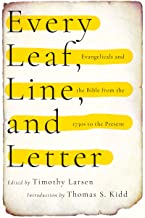
Timothy Larsen
Reviewed by: D. G. Hart
Every Leaf, Line, and Letter: Evangelicals and the Bible from the 1730s to the Present, edited by Timothy Larsen. InterVarsity, 2021. Paperback, 328 pages, $29.49 (Amazon). Reviewed by OP elder D. G. Hart.
With all the scholarly literature on evangelical Protestantism written over the last forty years, you might think that evangelicalism is fairly easy to identify. But that is a thought almost incomprehensible since the 2016 presidential election in the United States. Support for Donald Trump by Americans who identify as evangelical set off a flurry of new studies that question many of the older assessments of these Protestants.
The book under review, a Festschrift for David Bebbington, one of the leading historians of evangelicals, who almost thirty-five years ago supplied the categories for identifying evangelicals, reflects the pre-2016 understanding of conservative Protestants. An English Baptist who taught in Scotland at the University of Stirling for most of his career, Bebbington is well known in church history circles for his so-called “Bebbington Quadrilateral.” Its four themes are “conversionism,” or the necessity of the new birth or conversion experience, “biblicism,” or the supremacy of Scripture as the ultimate authority, “crucientism,” or salvation’s dependence on the atoning work of Christ on the cross, and “activism,” or the idea that true faith must be evident in word and deed.
This book awkwardly (and likely unintentionally) raises a question of whether all of these elements are necessary for inclusion in the evangelical movement. The editors decided to narrow the book’s frame of reference to the Bible. Scripture allows the authors, as Thomas Kidd explains in the introduction, to find a measure of unity “amid the vast ethnic, denominational, geographic, and cultural differences among evangelicals” (2). It also enables contributors to avoid the recent identification of evangelical Protestants with the Republican Party
The wisdom of that editorial decision becomes less evident in the essays themselves. In fact, the book unwittingly underscores the Roman Catholic objection to Protestantism, namely, that sola scriptura will generate more diversity than the unity supplied by the Vatican (though it is hardly clear that Roman Catholic history supports that point). The book includes a diverse set of topics, such as figurative readings of Scripture, use of the Exodus narrative for American independence, adaptations of the Bible for children in Sunday school, pro- and anti-slavery arguments, women’s rights advocates’ appeal to Scripture, opposition to theological modernism, the biblicism of liberal Anglicans, the Bible in the black church, American nationalism in The Patriot’s Bible, charismatics’ appeal to Scripture to justify ecstatic experiences, and the limits of evangelicalism in the Global South thanks to a dependence upon literacy.
The book includes worthy contributions to the study of Protestant history. But if they add up to any definition, they underscore how imprecise evangelicalism is as a descriptor of a certain kind of Protestantism. Bebbington’s quadrilateral was very instructive for his work on British Protestantism where the lines of ecclesiastical establishment and Dissenter defined much of the institutional landscape. But in the United States religious diversity has swamped the efforts of anyone, Reformed, Arminian, or evangelical, who tries to float a Protestant consensus.
As it turns out, religious experience may be the more basic category for understanding evangelicalism. Practically every Christian considers the Bible a source of divinely revealed truth and so venerates the Word of God in some fashion. But reading and understanding that holy book, or making it a priority in how to understand what we are to believe about God and what God requires of us, is another question altogether. This book is an indication of evangelicalism’s subjective and mystical tendency. Readers may well marvel at the variety of encounters that “born-again” believers have had with Scripture. At the same time, those with some ties to the churches of the Reformation will likely be left scratching their heads.
March 30, 2025
On the Trail with a Missionary
March 23, 2025
Midnight Mercies: Walking with God Through Depression in Motherhood
March 16, 2025
March 09, 2025
Zwingli the Pastor: A Life in Conflict
March 02, 2025
February 23, 2025
African Heroes: Discovering Our Christian Heritage
February 16, 2025
© 2025 The Orthodox Presbyterian Church